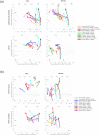Changing social inequalities in smoking, obesity and cause-specific mortality: Cross-national comparisons using compass typology
- PMID: 32649731
- PMCID: PMC7351173
- DOI: 10.1371/journal.pone.0232971
Changing social inequalities in smoking, obesity and cause-specific mortality: Cross-national comparisons using compass typology
Abstract
Background: In many countries smoking rates have declined and obesity rates have increased, and social inequalities in each have varied over time. At the same time, mortality has declined in most high-income countries, but gaps by educational qualification persist-at least partially due to differential smoking and obesity distributions. This study uses a compass typology to simultaneously examine the magnitude and trends in educational inequalities across multiple countries in: a) smoking and obesity; b) smoking-related mortality and c) cause-specific mortality.
Methods: Smoking prevalence, obesity prevalence and cause-specific mortality rates (35-79 year olds by sex) in nine European countries and New Zealand were sourced from between 1980 and 2010. We calculated relative and absolute inequalities in prevalence and mortality (relative and slope indices of inequality, respectively RII, SII) by highest educational qualification. Countries were then plotted on a compass typology which simultaneously examines trends in the population average rates or odds on the x-axis, RII on the Y-axis, and contour lines depicting SII.
Findings: Smoking and obesity. Smoking prevalence in men decreased over time but relative inequalities increased. For women there were fewer declines in smoking prevalence and relative inequalities tended to increase. Obesity prevalence in men and women increased over time with a mixed picture of increasing absolute and sometimes relative inequalities. Absolute inequalities in obesity increased for men and women in Czech Republic, France, New Zealand, Norway, for women in Austria and Lithuania, and for men in Finland. Cause-specific mortality. Average rates of smoking-related mortality were generally stable or increasing for women, accompanied by increasing relative inequalities. For men, average rates were stable or decreasing, but relative inequalities increased over time. Cardiovascular disease, cancer, and external injury rates generally decreased over time, and relative inequalities increased. In Eastern European countries mortality started declining later compared to other countries, however it remained at higher levels; and absolute inequalities in mortality increased whereas they were more stable elsewhere.
Conclusions: Tobacco control remains vital for addressing social inequalities in health by education, and focus on the least educated is required to address increasing relative inequalities. Increasing obesity in all countries and increasing absolute obesity inequalities in several countries is concerning for future potential health impacts. Obesity prevention may be increasingly important for addressing health inequalities in some settings. The compass typology was useful to compare trends in inequalities because it simultaneously tracks changes in rates/odds, and absolute and relative inequality measures.
Conflict of interest statement
The authors have declared that no competing interests exist.
Figures



References
Publication types
MeSH terms
LinkOut - more resources
Full Text Sources
Medical

